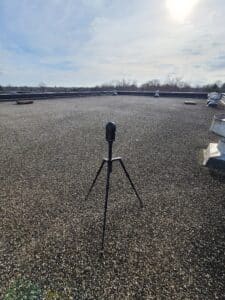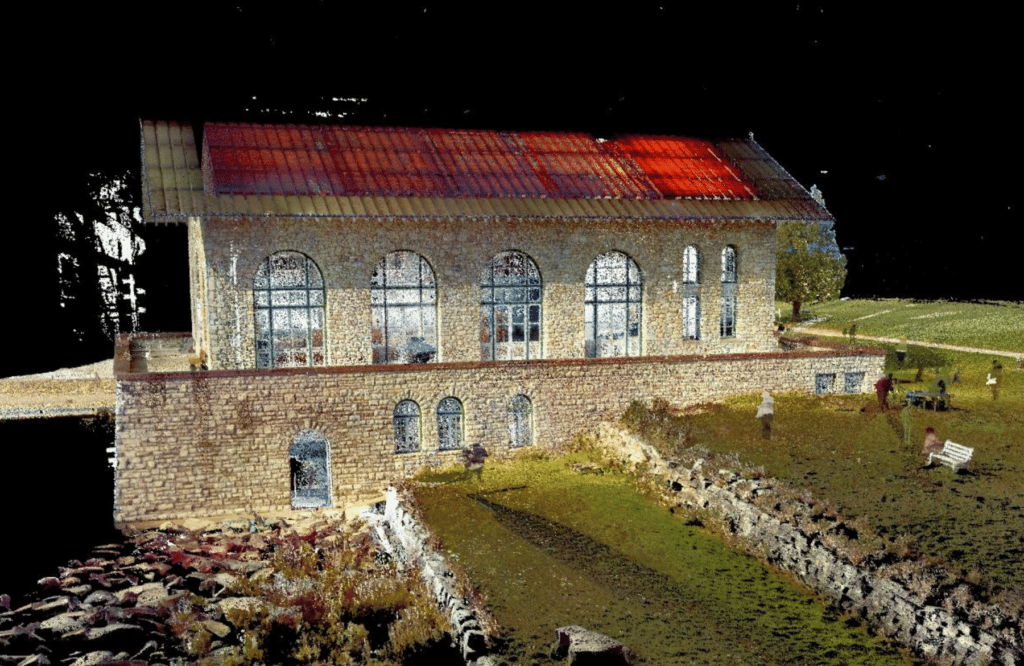As building assessment evolves, leading building envelope consultants use more advanced tools to streamline operations and provide more accurate results quickly and cost-effectively. One such tool, 3D laser scanning or LIDAR (Laser Imaging, Detection, and Ranging) laser scanning stands out for its precision, efficiency, and versatility.
This blog post explores the ins and outs of LIDAR laser scanning, tailored explicitly for building owners and property management professionals who have structures with building envelope issues (roof, exterior wall or below-grade waterproofing) or require high-precision data for building assessment.
What is LIDAR Laser Scanning?
At its core, LIDAR laser scanning is a remote sensing technology that uses laser light to densely sample the surface of an object, providing detailed 3D representations.
It is celebrated for its pinpoint accuracy—often within 1/8″ to 1/4″—thus allowing for a thorough analysis of visible building conditions. It can’t, unfortunately, see through walls!
Beyond measurement accuracy, the technology is instrumental in situations beyond the reach of drones, like structures surrounded by dense tree cover or indoor scanning. These 3D laser scans provide insights into the visible external conditions and configurations of areas otherwise obscured in point clouds or models from other 3D scanning techniques.
The Nitty-Gritty: How LIDAR Works

Employing a laser mounted on a tripod, technicians deploy LIDAR by strategically positioning the device around the structure for comprehensive coverage. The device sends out laser pulses that contact different surfaces and bounce back. These captured reflections create a “point cloud, ” an intricately detailed 3D model of the scanned building.
Applications in Architecture and Building Management
LIDAR scanning comes into its own in several critical applications within the building industry:
- Architecture and Engineering: Producing 3D models that serve as foundational tools in the design and review process for renovations or expansions.
- Construction: Enabling rapid identification of deviations from plans to facilitate timely corrections.
- Maintenance: Detecting early wear and tear signs, helping to preempt costly repairs.
- Rehabilitation: Detect and understand all the visible exterior system issues and pinpoint areas requiring further assessment with more hands-on, traditional methods and, ultimately, determine the scope of work for restoration and repair.
The Benefits: Saving Time While Improving Accuracy
One of the greatest strengths of LIDAR scanning is its ability to survey large spaces quickly, delivering cost savings and reducing labor. With higher accuracy than standard methods, LIDAR data yields a depth of understanding that contributes to more informed decision-making.
This technology fits seamlessly into landscaping and complex environmental challenges and offers indoor scanning capabilities that expand its versatility.
However, it’s important to note that, unlike drone surveys, LIDAR is ground-based and may require additional steps, such as lifting equipment, for comprehensive vertical scanning.
Weighing Options: LIDAR vs. Other Methods
So why choose LIDAR over traditional inspection techniques? Here’s a quick comparison:
- Speed: Rapid large-area coverage is at your fingertips with LIDAR, equating to less time on site and swift progress in building assessment.
- Detail: Generate high-resolution 3D models, giving stakeholders a granular look at the exterior state of the structure.
- Access: LIDAR navigates through where other methods may falter, whether it’s an intricate landscape or a tightly packed urban environment.
- Indoor Use: Not all technologies are adept for interior scanning, but LIDAR brings the outside capability inside.
Conclusion: Why LIDAR is Transforming Building Assessment

With its significant benefits, it’s easy to see how LIDAR laser scanning has gained traction in the building assessment industry. It presents a paradigm shift in how we comprehend structures, introducing levels of detail and efficiency that traditional methods struggle to match.
For those responsible for the integrity and maintenance of buildings, embracing LIDAR laser scanning can mean the difference between prevention and costly repairs, between guesswork and precision.
As we’ve seen, the application of LIDAR laser scanning extends far and wide, making it an indispensable tool in modern building assessment. Whether for detailed evaluations or periodic health checks of structures, LIDAR offers a clear advantage, echoing a more innovative, more informed approach to construction and maintenance.
To learn more about LIDAR laser scanning for exterior building assessment or management, contact BEPG, building enclosure consultants who integrate this powerful tool into the assessment processes and are experts at harnessing its full potential.
In addition, BEPG has been integrating LIDAR data with drone-generated meshes, pioneering a hybrid model that promises even greater accuracy for building assessments.
